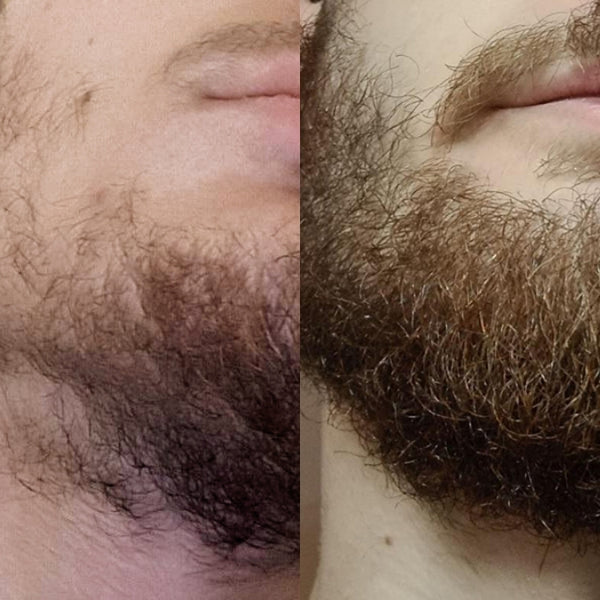How long does it take to grow a mustache?
A mustache can be a powerful symbol of masculinity and style. From timeless icons like Salvador Dali and Tom Selleck to modern-day influencers, men have adorned their upper lips with pride.
Embrace your adventurous side and give these alternative techniques a try!
Is a mustache a must-have?
However, just like every other style-choice, a mustache can also be dividing the pond. Especially if it is not taken care of. And the fact of the matter is, that growing a mustache also requires time, patience, and understanding of the natural mustache growth process.
In this blog post, we will explore the journey of cultivating a luscious mustache, shedding light on the timeline and factors that influence its growth.


Understanding the Growth Cycle
Before embarking on the quest for a remarkable mustache, it is essential to understand the hair growth cycle.
Facial hair, including mustaches, undergoes a three-phase cycle:
- Anagen
- Catagen
- Telogen
During the anagen phase, the hair follicles actively produce hair. The duration of this phase determines the length to which the hair will grow.
The catagen phase marks the transition when growth slows down
In the final telogan phase, the hair sheds and makes room for new growth.
Patience is Key
Growing a mustache demands patience. It is crucial to recognize that everyone's facial hair grows at a different pace.
On average, facial hair grows about 0.3 to 0.5 millimeters per day. While some may experience rapid growth, others might see slower progress.
It typically takes several weeks or even months to achieve a fully developed mustache. Remember, it is a gradual process, so resist the temptation to give up prematurely.
Yep. That means no to very little trimming the first month - at least!
Factors Influencing Mustache Growth
Various factors influence the growth of a mustache, and understanding them can provide insights into the journey ahead. Sadly, genetics play a significant role; if you come from a family with a history of thick mustaches, you may have an advantage, but there are things you can do to promote the growth rate besides having an overall health, of course.

Speeding up the mustache process
Instead of waiting for your mustache to flourish, taking care of it and stimulating it can speed up things quite a bit. First thing to remember: Diet.
Make sure you get the right nutrients and vitamins for your mustache to sprout. This includes Biotin, Zink, Selenium and Copper. Great foods for keeping a healthy hair growth.
Eggs, green leafy vegetables, citrus fruit and seeds and nuts. If you are unsure if you get all the needed vitamins we recommend a supplement like The Sidekick.
And while we’re at it, introducing a microneedle and an Activator growth serum to your routine can also help the process. If you are interested in further boosting your beard growth check out The Beard Growth Kit here.
Regular grooming and maintenance can also ensure healthy growth. Trim your mustache regularly to shape it and remove split ends - but give it at least a month before any snipping!
Additionally, keep the area clean by washing it thoroughly and using suitable beard products. Moisturizing the skin underneath can help prevent dryness and itching, making the growth process more comfortable.

Embracing the Stages
During the mustache-growing journey, you will experience various mustache growth stages. Initially, when growing a mustache in stages, it may be uneven and patchy, but don't lose hope. Embrace the process and give it time. As the hair fills in, you can experiment with different styles and grooming techniques to find what suits you best. Enjoy the transformation and remember that each stage contributes to the uniqueness of your mustache. Below you’ll find the 5 most common stages when growing one:
- The Stubble Stage: Initially, the growth appears as short and stubbly hair, often uneven and sparse.
- The Filling Stage: The mustache starts to fill in, and the hair becomes more noticeable. It may still be patchy in some areas.
- The Development Stage: The mustache begins to take shape, with more consistent growth and coverage. It starts to resemble a recognizable mustache style.
- The Mature Stage: The mustache is as established as your hairs allow and fully grown (in length).
- The Maintenance Stage: Once the mustache has reached its full potential, this stage involves regular trimming, grooming, and upkeep to maintain its desired appearance.
Seeking Professional Advice
If you feel unsure or have concerns about your mustache growth, it is advisable to seek professional advice.
Look in the right corner of your screen. See the little chat box?
Here are our Customer Team (yes, real people with years of experience in the field of beard growth) ready to answer all your questions.
Remember, professional guidance can help optimize your mustache-growing journey. Growing a mustache is a testament to your patience, perseverance, and understanding of the growth process. Embrace the stages, take care of your facial hair, and let time and work its magic. Remember, a banger mustache is worth the wait.
Go grow them whiskers, tiger!

FAQ

Simon Bang, Co-Founder
Meet Simon, one of the co-founders of Copenhagen Grooming. His passion for men's grooming and expertise in communication have shaped the brand's ethos. Simon curates grooming solutions, writes content, and educates about the products.
We're pretty sure you'll like these blog posts as well
Select your shipping destination
- Africa
- Americas
- Asia
- Europe
- Middle East
- Oceania









